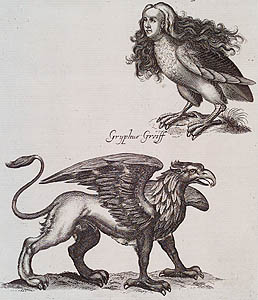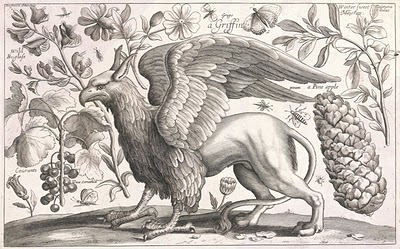parent nodes: Bestiário | Hipogrifo
Grifo
vb. criado em 09/05/2013, 23h43m.
lpd
Animal fabuloso, com cabeça de águia, corpo de leão e cauda de serpente. A união da águia e do leão, dois animais de caráter nitidamente solar, indica a tendência benéfica do grifo. Sua origem remonta à Babilônia, e esotericamente o grifo simboliza as forças protetoras e vigilantes que se encontram junto aos caminhos iniciáticos verdadeiros, assegurando proteção àqueles que os percorrem.
f.: Pellegrini, L. (1995). Dicionário de Símbolos Esotéricos. São Paulo: Editora Três.
2

"This majestic beast has pulled chariots of gods, guarded ancient treasures, cured human illness with its magic claws, pursued sinners. It has been the subject of travelers' tales and scientists' doubts and regarded as an animal of whimsy." This is how Joe Nigg describes what he calls the "most majestic of all mythical creatures" in his Book of Gryphons. I'm not going to write a whole book on griffins, of course, but I thought I'd feature them today - and seeing as this is the blog about juvenile fantasy and block prints, naturally I have to feature block prints of griffins.

A Griffin, etching by Wenceslaus Hollar, c 1646 (photo from University of Toronto Wenceslaus Hollar Digital Collection)
Griffins seem to have originated in the Near East around 3,000 BCE. It's fun to see how different artists through the ages have envisioned a beast that none of them has actually seen. The model griffin is half lion, half eagle, with the head, wings, and forelegs of an eagle and the hind quarters and ears of a lion - but all kinds of variants have existed through history. Perhaps that isn't surprising when we can't even agree on how to spell the creature's name!

The Griffin, etching by Martin Schongauer, 1475-1485 (photo by Vincent Steenberg on Wikimedia Commons)
Here (left) is a strange variant by Martin Schongauer, the fifteenth century master of wood engraving before Albrecht Dürer. The poor emaciated beast has ears more befitting a spaniel and the hind legs of some sort of cow or something, of all things. As for Dürer, he designed this more standard version (left) in 1515. (The block was carved by Hieronymus Andreae).

Gryphon, drawing by Sir John Tenniel, reproduced as a wood engraving for printing, (from Alice's Adventures in Wonderland, by Lewis Carroll, Macmillan, 1865)
One of the most classic griffins in more recent times is John Tenniel's illustration of the Gryphon in Carroll's Alice in Wonderland (below). This is just what a griffin ought to look like - although he doesn't necessarily behave as majestically as a griffin ought.
Here's a fun one drawn by Maurice Sendak to illustrate The Griffin and the Minor Canon by Stockton (below). Perhaps the interesting thing about this one is that while Sendak has shown a pretty standard griffin, Stockton's description of the beast in the story is a very strange griffin indeed. It has no hind legs but instead has a "body running out into a long and powerful tail, finished off at the end with a barbed point."
The gorgeous griffin at the top of the page is by eighteenth century etcher Wenceslaus Hollar. I love how it's displayed along with other elements of natural history - and with such lovely detail, too. It would be strange if they're all supposed to be to scale, though.
And here, of course, are my own offerings in the field of griffin art. This first fellow is based on a small carving of a griffin at the back gate of one of the buildings at Yale University. I think it's a juvenile. I adapted it, and added some details and texture, but the basic pose and proportions were copied from the carving. I'd love to give credit to the artist who made it in 1932, but I can't find his (or her, but probably his) name listed anywhere.
And my second griffin is Fastwings, from my book Kate and Sam to the Rescue.
Finally, if you're not sated with griffin art yet, check out the Gryphon Pages, with lots of nice images.
f.: aqui.
ENCYCLOPAEDIA V. 51-0 (11/04/2016, 10h24m.), com 2567 verbetes e 2173 imagens.
INI | ROL | IGC | DSÍ | FDL | NAR | RAO | IRE | GLO | MIT | MET | PHI | PSI | ART | HIS | ??? 


